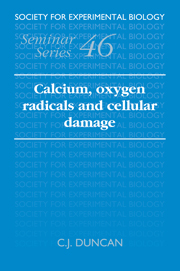Book contents
- Frontmatter
- Contents
- List of Contributors
- Preface
- 1 Are there common biochemical pathways in cell damage and cell death?
- 2 Free radicals in the pathogenesis of tissue damage
- 3 Calcium and signal transduction in oxidative cell damage
- 4 Regulation of neutrophil oxidant production
- 5 Reperfusion arrhythmias: role of oxidant stress
- 6 Biochemical pathways that lead to the release of cytosolic proteins in the perfused rat heart
- 7 Malignant hyperthermia: the roles of free radicals and calcium?
- 8 Free radicals, calcium and damage in dystrophic and normal skeletal muscle
- 9 Ultrastructural changes in mitochondria during rapid damage triggered by calcium
- 10 The importance of oxygen free radicals, iron and calcium in renal ischaemia
- 11 The Rubicon Hypothesis: a quantal framework for understanding the molecular pathway of cell activation and injury
- Index
11 - The Rubicon Hypothesis: a quantal framework for understanding the molecular pathway of cell activation and injury
Published online by Cambridge University Press: 18 January 2010
- Frontmatter
- Contents
- List of Contributors
- Preface
- 1 Are there common biochemical pathways in cell damage and cell death?
- 2 Free radicals in the pathogenesis of tissue damage
- 3 Calcium and signal transduction in oxidative cell damage
- 4 Regulation of neutrophil oxidant production
- 5 Reperfusion arrhythmias: role of oxidant stress
- 6 Biochemical pathways that lead to the release of cytosolic proteins in the perfused rat heart
- 7 Malignant hyperthermia: the roles of free radicals and calcium?
- 8 Free radicals, calcium and damage in dystrophic and normal skeletal muscle
- 9 Ultrastructural changes in mitochondria during rapid damage triggered by calcium
- 10 The importance of oxygen free radicals, iron and calcium in renal ischaemia
- 11 The Rubicon Hypothesis: a quantal framework for understanding the molecular pathway of cell activation and injury
- Index
Summary
Prologue
Calcium and oxygen are two of the major elements in the earth's crust (Campbell, 1983). Both are essential for maintaining the earth's ecosystem, and in particular for the existence and function of the human body. A further common link between calcium and oxygen in living systems is found in the biological molecules which bind Ca2+, where usually oxygen is the atom coordinating the Ca2+ (Duncan, 1976; Campbell, 1983). Yet both O2 and Ca2+ can be toxic, and even lethal, to cells and whole organisms. In spite of the abundance of calcium and oxygen in the substances which make up the earth's crust it is likely that, when life began 3500 million years ago, the concentration of free Ca2+ and O2 surrounding the first cells was much lower than it is today. Throughout evolution the physiology of cells has been intimately linked to their pathology, because of the necessity of developing defence mechanisms against chemical attack from Ca2+ or oxygen radicals, as well as other damaging chemical, physical and biological agents.
It has been known for nearly a century that a rise in cytosolic free Ca2+ is responsible for initiating cellular events such as movement, secretion, transformation and division (Heilbrunn, 1937; 1956; Duncan, 1976; Campbell, 1983, 1989a; Carafoli, 1987; Rasmussen, 1989; Reid, Cook & Luzio, 1989), and for certain defence mechanisms such as vesiculation (Campbell & Morgan, 1985; Morgan, 1989). Yet a prolonged, high level of intracellular free Ca2+ can irreversibly damage mitochondria, can cause chromatin condensation, precipitation of phosphate and protein and activate degradative enzymes such as proteases, nucleases and phospholipases.
- Type
- Chapter
- Information
- Calcium, Oxygen Radicals and Cellular Damage , pp. 189 - 217Publisher: Cambridge University PressPrint publication year: 1991
- 2
- Cited by



